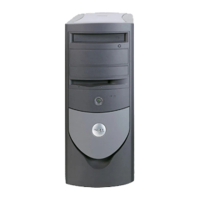Connecting a VGA Monitor
If you have a VGA monitor, plug the adapter cable into the white DVI display connector and connect the monitor cable to the adapter.
Connecting Two Monitors
Use the cable adapter to connect a VGA monitor and a DVI monitor to the DVI-I connector on the back panel.
When you connect two monitors, the driver will detect this connection and activate the multimonitor functionality.
Inside Your Computer
network speed to 10 Mbps to ensure reliable operation.
The amber light flashes when the computer is transmitting or receiving network data. A high volume of network traffic may make this
light appear to be in a steady "on" state.
Use the green line-out connector to attach an amplified speaker set.
line-in/
microphone
connector
Use the blue and pink line-in/ microphone connector to attach a record/playback device such as a cassette player, CD player, or VCR.;
or a personal computer microphone for voice or musical input into a sound or telephony program.
Use the back USB connectors for devices that typically remain connected, such as printers and keyboards.
Connect a serial device, such as a handheld device, to the serial connector.
If you have a DVI-compatible monitor, plug the cable from your monitor into the white connector on the back panel.
If you have a VGA monitor, see Connecting a VGA Monitor.
The connector for the power adapter.
See Diagnostic Lights for a description of light codes that can help you troubleshoot problems with your computer.
CAUTION: Before you begin any of the procedures in this section, follow the safety instructions in the Product Information Guide.
CAUTION: To avoid electrical shock, always unplug your computer from the power adapter before removing the cover.
NOTICE: To prevent static damage to components inside your computer, discharge static electricity from your body before you touch any of your
computer's electronic components. You can do so by touching an unpainted metal surface on the computer chassis.

